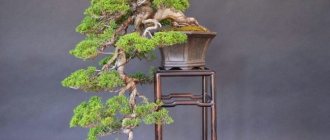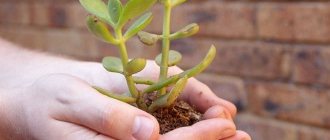Sakura impresses with its exquisite and uniquely delicate blossoms. In East Asia, the Japanese cherry tree is a national symbol that is protected by law. During its flowering, a holiday is held where everyone worships the fabulous tree.
Under natural conditions, the plant reaches several meters. Many people grow miniature copies. Sakura bonsai is an exact copy of an adult plant, reduced many times. It is worth noting that bonsai is a national culture of growing trees in a bowl.
Description of the plant
Sakura bonsai is an ornamental tree that does not require special care conditions. The plant is resistant to the dryness of city apartments, indoor gas pollution, watering and lighting.
Japanese cherry has become a favorite among gardeners due to its amazing flowering. Inflorescences with a diameter of 1 cm tightly frame the branches, creating a monochromatic cloud.
In nature, sakura blooms with bright pink flowers. Breeders have tried and artificially bred plants with a variety of shades.
Planting seeds - terms and rules
Planting seeds must be selected for a certain period of time, because seed development has a certain cycle. The optimal time is spring, as well as late summer or early autumn. At this time, the seeds are active and can provide good results.
A few practical tips that you can immediately apply:
- Inspect the seeds - if the skin is quite strong, then make small cuts. Perform the work carefully so as not to damage the inside. This way you open up the opportunity for the sprouts to quickly gain strength and emerge above the ground.
- Sow the seeds immediately after collection, without allowing them to lose their viability.
- The number of seeds should be 1.5 times greater than the planned number of plants. This is due to the fact that not all seeds will germinate, so you should be on the safe side.
- Depending on the size of the seeds, they can be planted one at a time (for large ones) and sown evenly over the entire surface of the soil (for small ones).
- Provide protection from direct sunlight.
- As the first shoots appear, you can increase the supply of fresh air by lifting the film or glass lid that covers the seeds.
Following established rules for working with sakura seeds allows you to get excellent and healthier plants. Proper care during the germination stage determines the quality of the plant in the long term.
How to grow a tree from seeds
Sakura bonsai, like other plants, can be grown by seed. True, this process is very difficult and very troublesome. Since bonsai takes 15-20 years to form, homemade sakura will require a lot of patience.
Where to buy sakura seeds and how to grow a flowering plant at home is of interest to many beginners and amateurs. After all, sakura is a plant with amazing flowering, and its formation in the form of a tree on a tray will be the most exciting activity.
Japanese cherry seeds are purchased at specialized garden centers, although they appear there very rarely.
Advice! If you find sakura seeds, you should stock up on planting material, since they sprout “infrequently and sparsely.” According to the observations of professionals, out of 10 seeds, only 1-2 germinate, that is, the germination percentage is 10-20%.
There is a technology for growing sakura from seeds at home:
- After purchasing, each seed should be scarified (pricked, filed), since their shell is very durable.
- Place in warm water for 24 hours to swell.
- After this - into moist soil to a depth of no more than 2 cm.
- Cover the pot with film and place in a cool place (bottom shelf of the refrigerator, cellar). The stratification period is 60-70 days.
- After the “cooling” period has expired, the pot is placed in a bright place and kept at room temperature.
- When seedlings appear, young specimens should be immediately transplanted into special bonsai pots - flat pots. When picking in groups, the distance between young plants should not be more than 10 cm.
Important! The sakura plant has many varieties, each of which has special characteristics and requirements for cultivation. That is why, when purchasing seeds, it is recommended to study what kind of soil, watering and fertilizing regime a particular variety of Japanese cherry prefers.
Sakura seeds are sown in April-May. The soil used is a mixture of coarse sand, sphagnum moss, and vermiculite. The first sprouts appear within 2 weeks after moving the flowerpots to heat.
The incomparable blossoming of sakura, photos of which are presented on the Internet, pleases the eye much earlier than the appearance of leaves and other flowers in the garden. As a rule, already in April-May the tree is densely covered with flowers up to 1 cm in diameter. The month of cherry blossoms depends on the climatic conditions of the region and the plant variety. Unfortunately, the flowering does not last long, but the beautiful pink cloud is replaced by noble greenery. And Sakura again captivates with its appearance.
How to plant potted sakura is recommended by professionals. Despite the variety of the species, young plants need picking. In addition, seedlings are replanted every 3-4 years as they grow (replantation is not performed in winter - the plant is dormant).
How to plant and pick sakura at home
Proper planting is half the success of future sakura growing:
- treat the seeds with a fungicide;
- moisten the substrate;
- deepen the seeds half a centimeter into the grooves made (there should be at least 3 cm between them);
- cover the planting with a thin layer of fine-grained sand;
- cover the pot with film or glass;
- leave at a temperature of +5…10 °C.
Attention! Gardeners recommend planting seeds in the spring or at the turn of August and September.
Seedlings should appear in 1.5-2 weeks. Until this point, care consists of keeping the top layer of soil moist, providing plenty of light, and gradually raising the temperature to room temperature. When shoots appear, plant them in separate pots. The distance between seeded seedlings should not be more than 10 cm if you move them to a new common container.
Sakura blossom
Picking is an important condition for the normal development of sakura. Repeated transplants help strengthen the root system. Sakura seedlings are left untouched only in the cold season. They are placed in a cool, shaded room until spring. The key point in picking grown seedlings is the selection of new pots. The gardener has two options:
- leave the crop to grow in a cramped container and form a bonsai version of the tree;
- move it to deeper and wider pots and prepare the tree for the garden.
Picking
Plant picking is extremely important for the development of a tree. The first picking should be carried out immediately after germination. Small seedlings are planted in 100 ml cups. The substrate is made up of 7 parts turf soil, 3 parts sand (disinfection and roasting in the oven are mandatory) and 1 part humus. During the first pick, the root is shortened by 1/3.
The second picking of plants is carried out after 2 months. During the period of work, the root is pinched by 2/3 and the plant is slightly buried. The soil used is of the same composition.
The third pick is carried out after the sakura grows. But not more often than 2 months after the second procedure. It is recommended to repot the plant when the plant to pot height ratio is 2:1.
Preparing seeds and soil
You can’t just take seeds and place them in the soil - you won’t get the expected result. To properly grow sakura, you will need to comply with certain norms and rules, including the preparation of the soil and the seeds themselves.
During the period of working with sakura, gardeners developed certain rules:
- Before directly planting seeds in the soil, they should be placed in warm water for 24 hours. The temperature should be 25-30 degrees. During soaking, it is recommended to add a certain amount of fungicide to the water, which helps effectively combat fungal diseases. This is a serious threat to the development of the plant, so it is important to secure the tree at the earliest stage when it is most vulnerable.
- The best soil for sakura is coarse sand. This way, sakura seeds germinate quite quickly and guarantee good results. To speed up growth, you can pierce the seed coating to facilitate sprout germination. Be sure to disinfect the soil - this way you will eliminate possible organisms developing here and protect the seeds from damage by pests.
- At the stage of sowing seeds, fertilizers do not need to be applied - natural minerals in the soil and accumulated in the seed are quite sufficient at the first stage of growth.
- The sand is moistened abundantly before planting - rapid growth will require a large amount of moisture. Special shallow grooves are made in the sand, into which the seeds are placed. The distance between the seeding strips should not be less than 3 centimeters - the plants can interfere with each other and limit their development.
After placing the seeds in the ground, they are sprinkled with sand for additional protection and to create conditions for development. The top layer should be no more than twice the diameter of the seed.
Bonsai care rules
There is very little information about sakura: what kind of tree is it, how to care for it? Those who were lucky enough to grow a blooming beauty from seeds say: indoor sakura is very difficult to care for and requires daily attention. Although seed sellers claim its unpretentiousness.
Competent tips on how to care for sakura at home include:
- Organization of the watering regime: in summer the tree is watered with 100-125 ml of water per day, in winter watering is reduced.
- Creating a sufficient amount of light: bonsai pots are kept in the brightest rooms, but without drafts or direct sunlight.
- Annual replanting with shortening of the root system: the plant is grown in a bowl with a diameter of 15-20 cm.
- Soil preparation in accordance with the requirements of a particular variety: sakura loves nutritious soil with a high content of nitrogen, humus, and potassium.
Important! Organic fertilizers are applied to the soil a month before replanting the plant, that is, the soil for sakura is prepared in advance. Mineral fertilizers are added during the transplantation period.
When growing a tree in the bonsai style, you should also worry about the formation of the crown. The trunk of a young plant is fixed with wire, and characteristic bends are created if necessary. When the plant rises 20-30 cm, the main trunk is cut off. This promotes the formation of side shoots.
Bonsai is a miniature tree that requires constant pruning. The side shoots are pruned after flowering, shaping the direction of the branches.
Important! A simple way to control the growth of a bonsai is to make a series of horizontal cuts in the tree bark. Mechanical damage leads to weakening of the tree and stops its development. But this should be done extremely carefully.
Currently, there are a huge number of ways to form a crown. Creation of an individual style begins when the plant is 2-3 years old.
Even with minimal care and the creation of optimal conditions, the plant will delight you with its flowering every year.
How to prune bonsai sakura correctly
To grow miniature crops, experts use various tricks and techniques. The goal is to make even a young tree look like a hundred-year-old tree. For this:
- Expose some of the roots by removing a small layer at the base of the trunk. It should be thick. To do this, regularly remove all vertically growing shoots.
- The barrel should not be too long. Cut off part of the root at its base. When replanting, deepen the cutting area into the ground. Over time, new roots will grow on it. Then the tree can be picked again, removing the old rhizome.
- The heaviest branch of the tree will be the bottom one. Which shoot to leave for its formation - decide based on the compositional idea.
- For a broom-shaped crown, prune vertically growing branches as much as possible. For a vertical one, on the contrary, protect vertical branches. In this case, only horizontal ones are cut.
The bonsai tree needs all these manipulations constantly. Otherwise it will lose its shape. The gardener's goal is to maximize the decorative effect of sakura. If you adhere to cultivation technology, provide the plant with a little care and attention every day, then the Japanese guest will delight you with lush, large and bright colors every spring.











